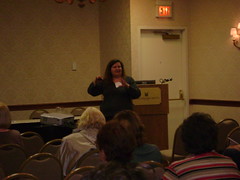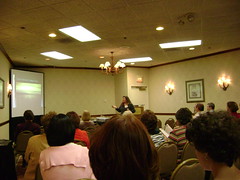Kim Flores & Mel Davis from Springfield Green library
Video – A Guy Walks Into A Library from Pike’s Peak Library (on VHS…)
“Every business chooses the kind of customer service they want to provide”
* Place
* Product
* Process
* People
* Promotion
* Personal Service
* Public Relations
Consistency in all the “P’s” is very important – training is VERY important
Employee empowerment is key – they need to feel like they have the power to make customers/patrons happy
We assume patrons will not have the correct information and it can show in our service.
Reputation of unfriendliness is PR – just not good PR…
(from brainstorming activity)
17 bad examples, 4 good examples – it’s so much easier to remember the bad than the good.
What can you change? – training, publicity
how does it affect patrons? – inconsistent application of policy, not being able to help patrons find/discover our resources
Quotes from real patron comment cards and discussion of how to fix the issues.
* wear identification to show you work there
* ask how their experience was
Customer Service Standards for SGCL (Springfield-Greene County Libraries)
* develop list of cs priorities
* combined from each branch and adopted library-wide
* basic expectations
* Acknowledge each customer in a pleasant manner and create an open, welcoming environment
(we can’t verbally do this in the PCC, but we could work on smiling at patrons as they enter and thanking them for waiting when we get busy)
* Maintain an awareness of customers in the building or service area – safety and CS – give customers your full attention as they approach a service desk
(take your hand from the mouse as you ask if you can help them – give them your full attention)
* Assess the level of need for assistance in locating materials or using the facility – approach customers and ask them if they need help
(make customers feel special – even if you are working on 15 things at once)
* Appear approachable
(limit personal conversations in public areas – practice interrupted sentences, invite customers to return, smile)
* Ask questions to determine specific needs of the customer
(ask to put someone on hold, thank them for holding)
* Respond positively & find ways to say YES
(options…)
* Eliminate jargon
* Clearly communicate expectations the customer may have
(underpromise and overperform)
* Deliver service that exceeds the customer’s expectations
* Become well-versed in library policies, procedures, programs, etc.
(morning meetings to get everyone aware of what is going on in the library that day)
* Possess broad knowledge of resources & services
* Support your co-workers
* Provide services in a consistent manner
* Communicate (and understand) why you follow the policies that are in place
* Monitor customer behavior & enforce policies to create an atmosphere conducive to library functions
What about patrons who insist on dictating the library atmosphere? – talk to the patron and keep a file on discussions and maybe ban ’em. Many stories about patrons going wild in the library
What about No?
3-step process
* explain the reason
* show empathy
* let the customer know what you can do
Avoid “you have, you are” – change it to “please lower your voice” or “there is a balance on your card”
No debating. Inform them of what you want them to do (don’t ask) and walk away.


